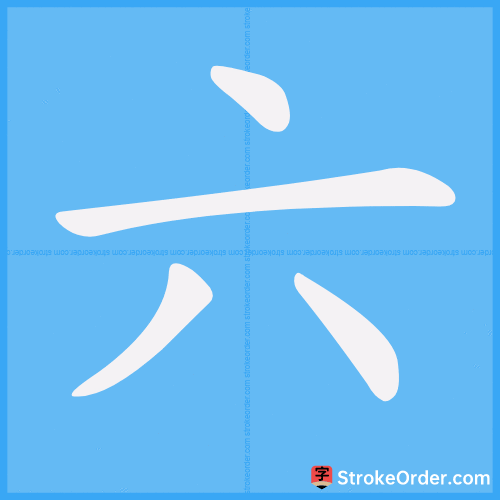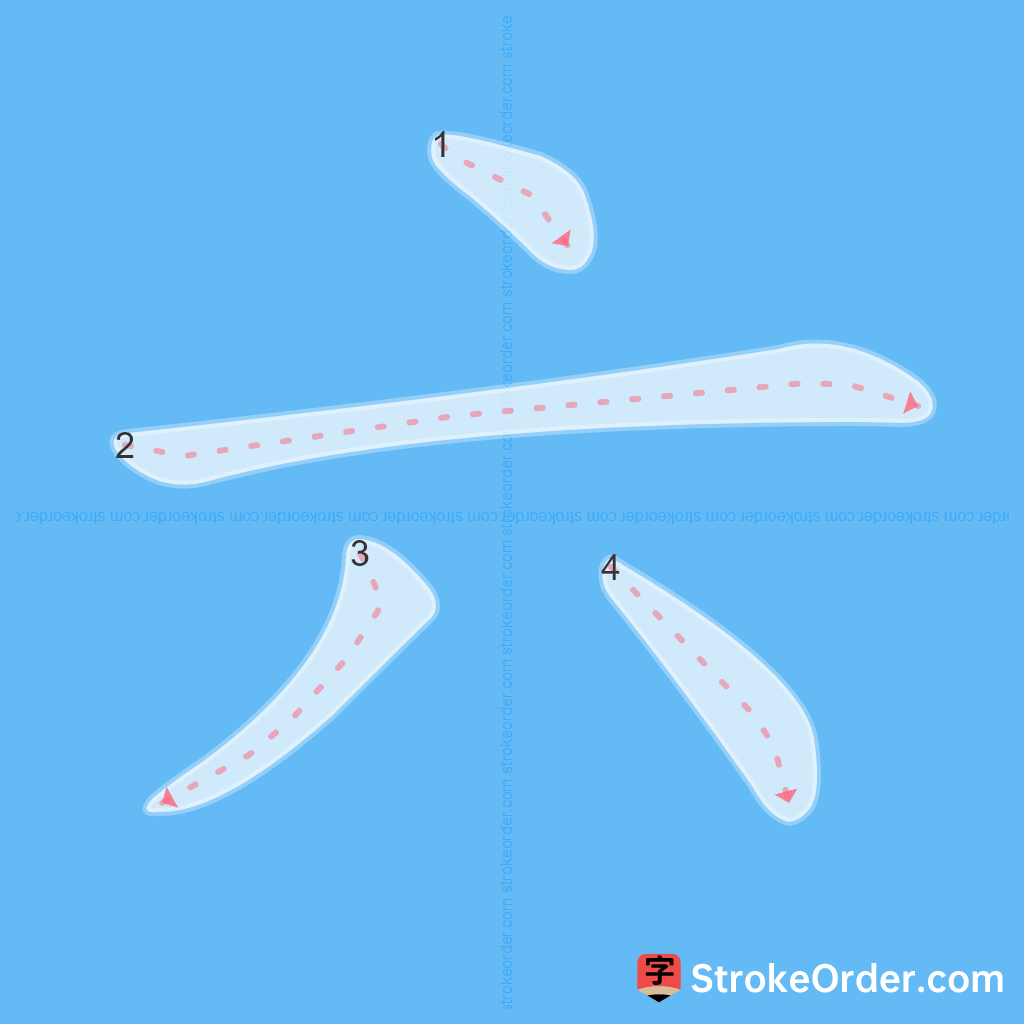六 Stroke Order
Animated Stroke Order of 六

Stroke Order Diagrams for 六

Step-by-Step Handwriting Guide for 六

Learn to Write Chinese Characters with Video Tutorials
Watch the video of writing the Chinese character "六", learn the correct stroke order (笔顺) of the character "六", and master the standard way of writing the character "六".
Free Printable Handwriting Practice with Stroke Order: 六
Printable Writing Practice Worksheet of "六" in Portrait Orientation (Tian Zi Ge)

Printable Writing Practice Worksheet of "六" in Landscape Orientation (Tian Zi Ge)

Information of 六
Pinyin
liù、 lù
Radical
八
Strokes
4 strokes
Usage
★★★★★
Definition
six / 6
六 [liù]
1. Number, representing five plus one (often written as “陆” in uppercase on bills or documents).
数名,五加一(在钞票或单据上常用大写“陆”代)。
2. In ancient Chinese musical notation, a symbol equivalent to the simplified notation "5".
中国古代乐谱的记音符号,相当于简谱“5”。
- 六书 (liù shū): Ancient methods of analyzing Chinese characters, categorizing them into six types.
- 六甲 (liù jiǎ): (Reference to six types, historically referring to "father", "mother", "wife", "child", "brother", "younger brother".)
- 六艺 (liù yì): (i.e., six arts: "ritual", "music", "archery", "equestrianism", "writing", "mathematics"; also refers to the Six Classics.)
- 六欲 (liù yù): (A Buddhist term referring to various human desires, including visual, bodily, behavioral, auditory, tactile, and thought desires.)
- 六合 (liù hé): The directions "East", "South", "West", "North", "Up", "Down", representing heaven and earth.
- 六亲 (liù qīn): Generally refers to all relatives, originally signifying "father", "mother", "wife", "child", "brother", "younger brother".
- 六经 (liù jīng): Refers to the six Confucian classics, namely "Book of Songs", "Book of Documents", "Book of Changes", "Book of Rites", "Book of Music", and "Spring and Autumn Annals".
- 六畜 (liù chù): Refers to six domestic animals: "pig", "cow", "sheep", "horse", "chicken", "dog".
- 六朝 (liù cháo): Refers to the six dynasties that established their capitals in Jian Kang, modern-day Nanjing, Jiangsu Province, and is broadly used to refer to the Southern and Northern Dynasties.
- 六腑 (liù fǔ): In Traditional Chinese Medicine, refers to "stomach", "gallbladder", "large intestine", "small intestine", "bladder", "san jiao".
- 六言诗 (liù yán shī): Six-character poetry.
- 六弦琴 (liù xián qín): Six-stringed zither.
3. (In the context of I Ching) In the hexagrams, the Yin line is called "six".
中国古代乐谱的记音符号,相当于简谱“5”。
4. Six times.
六次 ([En.] six)
6. (Other meanings)
a. (as a note of the scale in gongchipu) ([En.] a note of the scale on gongchipu)
b. Ancient country name ([En.] Liu state) located north of today's Liu'an, Anhui Province.
c. Surname.
d. See also lù.
1. 〔刘安〕: A place name in Liu'an, Anhui Province, China.
〔安合〕: A place name in Jiangsu Province, China.
6 [lù]
1. Ancient country name ([En.] Lu state), with the old capital located in modern Liu'an, Anhui Province.
古国名 ([En.] Lu state)。故城在今安徽省六安县北
2. Ancient county name ([En.] Lu county), located in present-day Liu'an County, Anhui Province.
古县名 ([En.] Lu county)。在今安徽省六安县
3. To see also liù.
另见 lù.
the six directions (north, south, east, west, up, down) / the whole country / the universe / everything under the sun
lit. to cross five passes and slay six generals (idiom) / fig. to surmount all difficulties (on the way to success)
Input Method for 六
Pinyin
liu4
Wubi
uygy
Cangjie
yc
Zhengma
sovv
Four Corner
00800
Unicode
U+516d
Same Pronunciation Characters